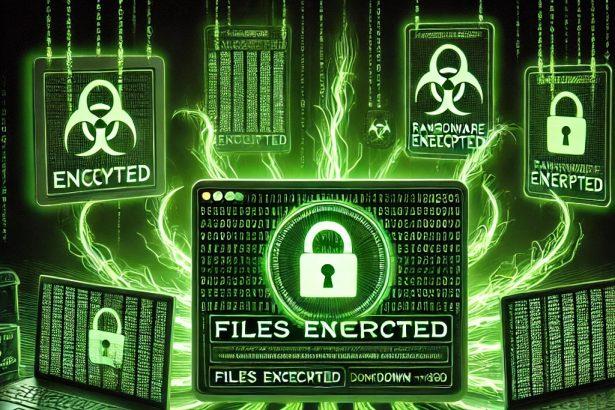SafePay emerged in late 2024 and escalated quickly. A high-profile attack in October hit a UK-based logistics tech firm, encrypting systems and leaking over a terabyte of data. By early 2025, SafePay ranked among the top 10 most active ransomware threats globally.
Threat Overview
SafePay is a ransomware strain targeting businesses of all sizes, particularly those using exposed RDP or unpatched VPN gateways. It combines rapid file encryption with stealthy data exfiltration, then demands payment under threat of public exposure.
Key Details
| Field | Value |
|---|---|
| Threat type | Ransomware, cryptovirus |
| Encrypted extension | .SafePay, .safepay |
| Ransom note name(s) | readme_SafePay.txt, readme_safepay.txt |
| Contact channels | Tor or TON leak site |
| Detection names | SafePay, LockBit variant (varies by AV) |
| Symptoms | Sudden file encryption, missing shadow copies, disabled antivirus |
| Damage | File loss, business disruption, reputational risk via data leaks |
| Distribution methods | Compromised RDP/VPN, phishing, cracked software, malicious scripts |
| Severity | Critical |
| Removal tool | SpyHunter or other enterprise-grade antivirus |
In‑Depth Analysis
Infection Vector
Threat actors typically access systems through stolen RDP or VPN credentials. Some cases involved exploitation of VPN vulnerabilities or phishing campaigns aimed at network administrators. Once inside, attackers run PowerShell scripts to map shares and move laterally.
Behavioral Profile
- Initial breach via RDP/VPN or spear phishing
- Security disablement, including Windows Defender and antivirus processes
- Lateral movement using PowerShell tools like ShareFinder.ps1
- Data exfiltration using archiving tools and FTP clients
- Encryption phase targets key file types; adds
.SafePayextension - Backup sabotage by deleting shadow copies and scheduled restore points
- Ransom demand issued via a note; victims directed to leak site
Risk Assessment
SafePay uses centralized infrastructure rather than relying on affiliates. Its approach resembles LockBit 3.0, with added emphasis on operational speed and stealth. Victims span industries—from MSPs to distributors—and often experience both encryption and data leaks within hours of compromise.
Artifact Text
Ransom Note:
Your files have been encrypted with SafePay.
To recover them, visit our Tor or TON site and get the decryption key.
Don't try to restore via backups or AV: they have been disabled.
You have 72 hours. After that your data is published.Manual Ransomware Removal Process
Important: Manual removal is recommended only for experienced users, as incorrect actions can lead to data loss or incomplete removal of the ransomware. If unsure, consider the SpyHunter Removal Method for a guided, automated solution.
Step 1: Disconnect from the Internet
- Immediately disable Wi-Fi or unplug the Ethernet cable to prevent the ransomware from communicating with remote servers.
- This can prevent additional encryption or further infections.
Step 2: Boot into Safe Mode
For Windows Users
- Windows 10/11:
- Press Windows + R, type
msconfig, and press Enter. - Under the Boot tab, select Safe boot and check Network.
- Click Apply, then OK, and restart your PC.
- Press Windows + R, type
- Windows 7/8:
- Restart your PC and press F8 repeatedly before Windows starts.
- Select Safe Mode with Networking and press Enter.
For Mac Users
- Restart your Mac and hold the Shift key immediately after the startup chime.
- Release the key when the Apple logo appears.
- Your Mac will boot in Safe Mode.
Step 3: Identify and Terminate Malicious Processes
Windows
- Open Task Manager by pressing Ctrl + Shift + Esc.
- Look for unusual processes consuming high CPU or memory.
- Right-click on the suspicious process and select End Task.
Mac
- Open Activity Monitor (Finder > Applications > Utilities > Activity Monitor).
- Look for unknown or high-resource-consuming processes.
- Select the suspicious process and click Force Quit.
Step 4: Delete Ransomware Files
Windows
- Open File Explorer and navigate to:
C:\Users\[Your Username]\AppData\LocalC:\Users\[Your Username]\AppData\RoamingC:\Windows\System32
- Identify and delete suspicious files (randomly named or recently modified items).
- Clear temporary files:
- Press Windows + R, type
%temp%, and hit Enter. - Delete all files in the Temp folder.
- Press Windows + R, type
Mac
- Open Finder and select Go > Go to Folder.
- Type
~/Library/Application Supportand check for unfamiliar files or folders. - Remove unknown
.plistfiles from~/Library/LaunchAgents.
Step 5: Remove Ransomware Entries from Registry or System Settings
Windows
- Press Windows + R, type
regedit, and hit Enter. - Navigate to:
HKEY_CURRENT_USER\SoftwareHKEY_LOCAL_MACHINE\Software
- Identify and delete ransomware-related registry entries.
Mac
- Open System Preferences > Users & Groups.
- Select the Login Items tab and remove any unknown startup programs.
- Check
~/Library/Preferencesfor malicious settings.
Step 6: Restore System Using a Backup or Restore Point
Windows
- Press Windows + R, type
rstrui, and press Enter. - Choose a restore point from before the infection and proceed.
Mac
- Restart your Mac and enter macOS Utilities by holding Command + R.
- Select Restore from Time Machine Backup and restore a safe backup.
Step 7: Attempt to Decrypt Files
- Check No More Ransom (www.nomoreransom.org) for available decryption tools.
- If unavailable, restore files from backups.
Automated Ransomware Removal with SpyHunter
If manual removal is too complex or risky, SpyHunter offers a safer, automated method for detecting and removing ransomware.
Step 1: Download SpyHunter
- Get SpyHunter from the official Enigma Software website.
Step 2: Install SpyHunter
- Open the downloaded file (
SpyHunter-Installer.exeor.dmgfor Mac users). - Follow the installation prompts.
- Launch SpyHunter upon completion.
Step 3: Run a Full System Scan
- Click Start Scan Now to detect malware and ransomware.
- Wait for the scan to complete and review detected threats.
Step 4: Remove Detected Ransomware
- Click Fix Threats to remove identified ransomware components.
- SpyHunter will clean your system automatically.
Step 5: SpyHunter’s Custom Malware HelpDesk
- If ransomware persists, use SpyHunter’s Malware HelpDesk for custom malware fixes.
Step 6: Restore Files
- Use backups stored on external drives or cloud storage.
- If no backup is available, check No More Ransom for decryption tools.
Preventing Future Ransomware Attacks
- Keep backups: Use cloud storage or an external hard drive.
- Install a reliable security tool: SpyHunter offers real-time protection against malware.
- Enable Windows Defender or Mac security features for additional protection.
- Avoid phishing emails and unknown attachments.
- Regularly update Windows, macOS, and installed applications.
Conclusion
SafePay represents the new wave of ransomware: fast, efficient, and designed for maximum leverage. It leaves minimal room for recovery unless systems are proactively defended and backups are kept offline. Early detection, privileged access controls, and layered defense remain critical.




